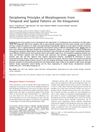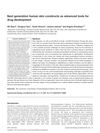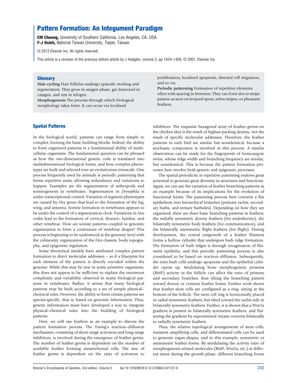TLDR The conclusion is that understanding how patterns form in biology is crucial for advancing research and medical science.
The document from 2013 explores the principles of pattern formation in biological systems, particularly in integumentary structures such as feathers and hair. It describes the complexity of patterns in vertebrates, which are formed through a combination of physical-chemical rules and genetic information, exemplified by the Turing reaction-diffusion mechanism in feather development. The article also discusses the temporal patterns of hair follicles, influenced by hormones and environmental factors, and the significance of these patterns in tissue regeneration, engineering, and medical applications. It highlights the importance of pattern formation in biological communication and speciation, with examples like cephalopod camouflage and bird plumage, emphasizing the necessity of understanding morphogenesis for advancing biological research and medical science.
 176 citations
,
April 2011 in “Science”
176 citations
,
April 2011 in “Science” Hair stem cell regeneration is controlled by signals that can explain different hair growth patterns and baldness.
 829 citations
,
May 2007 in “Nature”
829 citations
,
May 2007 in “Nature” Hair follicles can regrow in wounded adult mouse skin using a process like embryo development.
112 citations
,
January 2004 in “The International journal of developmental biology” Feather patterns form through genetic and epigenetic controls, with cells self-organizing into periodic patterns.
112 citations
,
January 2004 in “The International journal of developmental biology” Feather patterns form through genetic and epigenetic controls, with cells self-organizing into periodic patterns.
 19 citations
,
April 2015 in “Developmental Dynamics”
19 citations
,
April 2015 in “Developmental Dynamics” The conclusion is that skin and hair patterns are formed by a mix of cell activities, molecular signals, and environmental factors.
 69 citations
,
June 2017 in “Experimental Biology and Medicine”
69 citations
,
June 2017 in “Experimental Biology and Medicine” Advanced human skin models improve drug development and could replace animal testing.
September 2025 in “Biomolecules” The skin microenvironment significantly affects hair growth and loss, offering potential treatment avenues.
41 citations
,
July 2019 in “Clinical Cosmetic and Investigational Dermatology” The skin's immune system helps it regenerate and fight infections.





